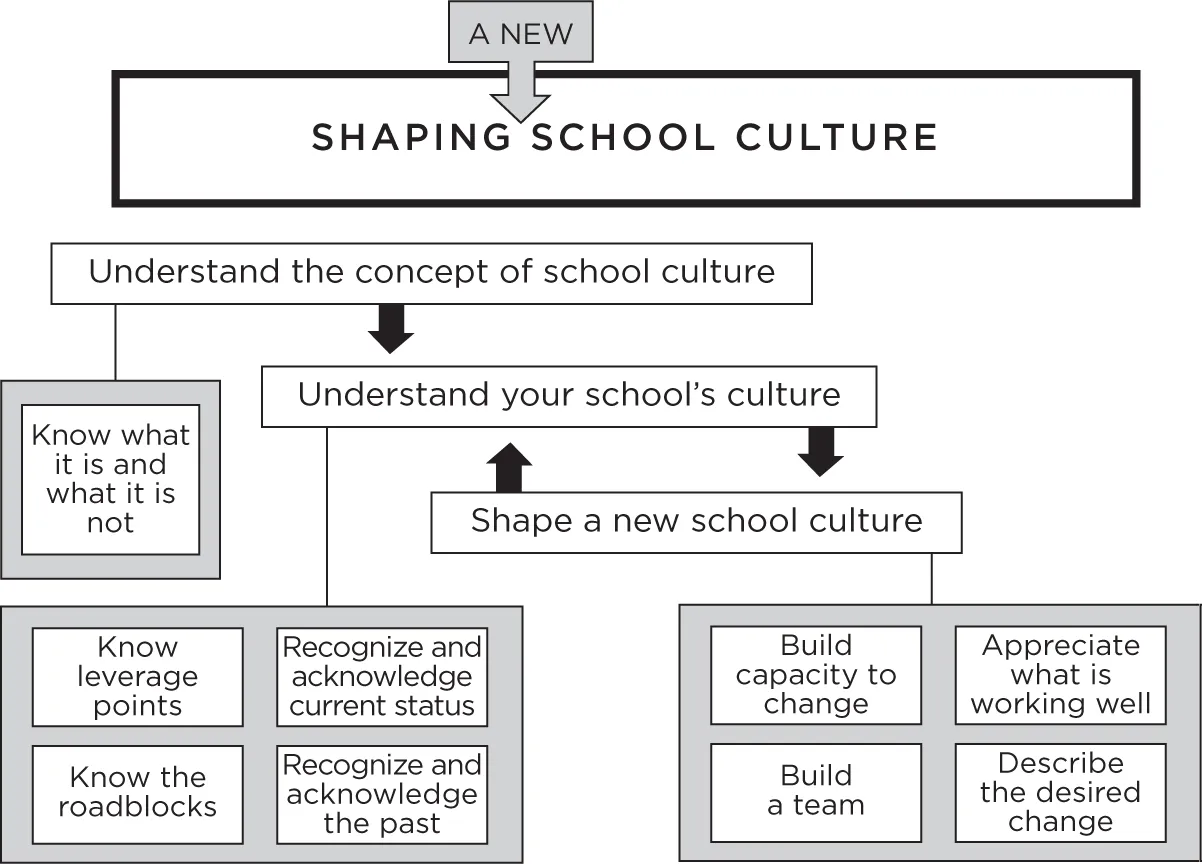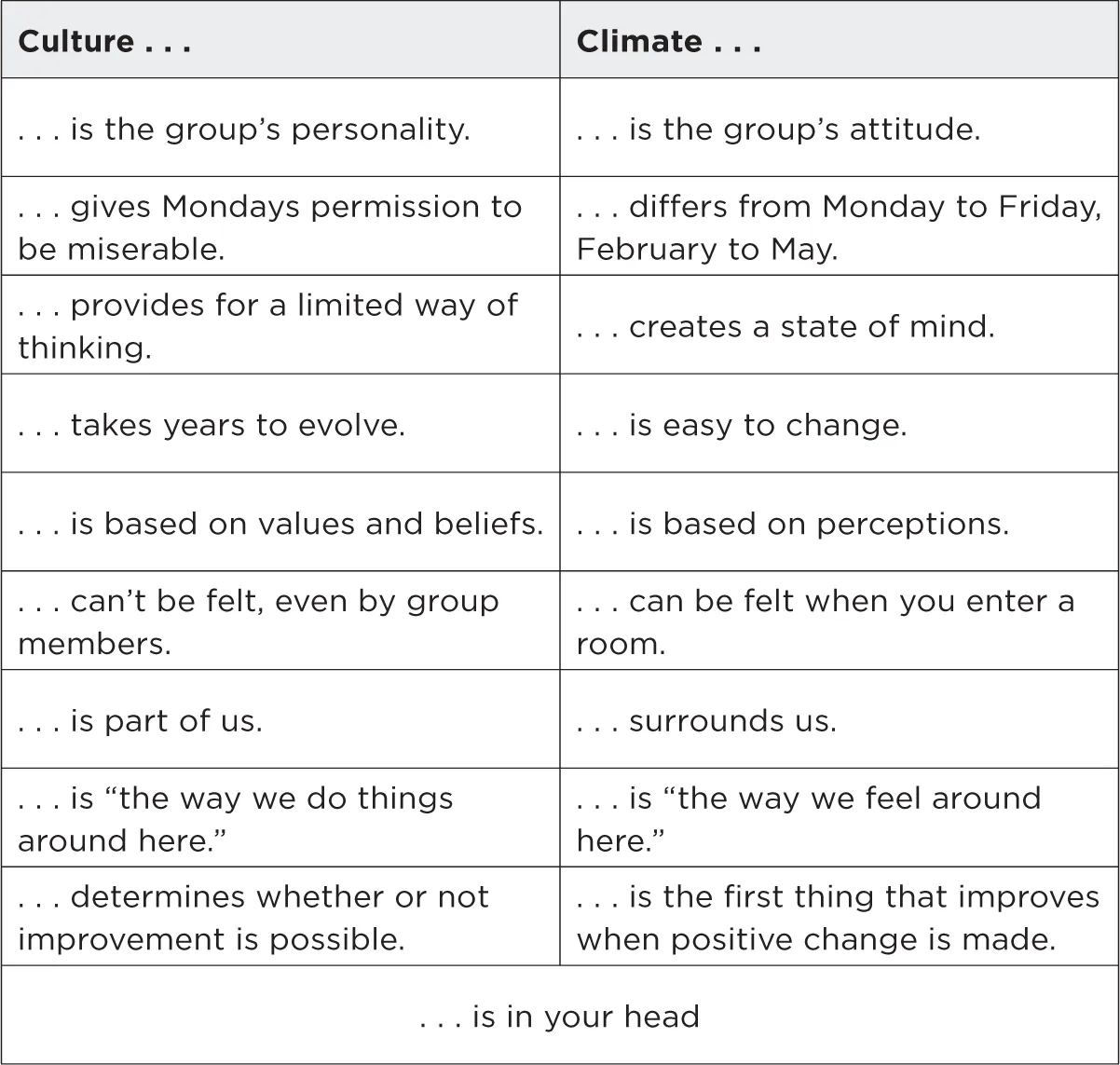![]()
Chapter 1
Defining Organizational Culture
. . . . . . . . . . . . . . . . . . . .
Have you ever noticed how service can vary from restaurant to restaurant? At some, you walk in and are greeted by a friendly, attractive host who whisks you away to an available table; at others, you can't get anyone to make eye contact with you, let alone greet you in a friendly way. Often, such a disparity can be found among restaurants that are part of the same chain! What is going on? How can two restaurants from the same company be so dramatically different?
Similar disparities can be found between and within schools and districts: You walk into some schools and immediately feel welcome; you walk into others and you feel like an intruder. In some schools, every teacher seems to be out from behind the desk, lessons are infused with technology, and students appear to be highly engaged in learning; in others, teachers seem to use their desks as fortresses and students appear distracted or disengaged. In both schools, teachers will tell you that what they're doing is effective.
Why is it that some schools embrace new ideas, while others consider them distractions? Why do some teachers roll up their sleeves, while others simply roll their eyes? More important, is there anything we can do to address these differences? Often, disparities within schools and districts are the result of separate cultures having been established over time. For schools to be effective, educators need to understand the organizational cultures in which they work and be able to modify them if necessary.
Understanding an Elusive Concept
This book is intended to help you better understand the general concept of school culture, learn the strengths and weaknesses of your specific school culture, and—perhaps most important—influence your school culture or, if necessary, shape a new one (see Figure 1.1). In the following pages, you'll learn what to do, what to expect, and what positive and negative signs to look out for when trying to improve your school's culture.
Fig 1.1 The Keys to Shaping a New School Culture
To improve your school culture, you must dig deep into the psyche of your organization and figure out why certain actions or attitudes are entrenched. Often, such actions or attitudes are actually rewarded by a school's culture, so any desirable new behaviors will need to be rewarded by the culture as well if they are to be sustained. Indeed, the effect of school culture on teacher and student behaviors cannot be understated.
You may be thinking, But surely people choose what to do in every situation—it's not as though we're robots programmed to act a certain way when we arrive at school, right? The fact is, the whole purpose of a school culture is to get members to adopt predictable behaviors and a common mental model. Culture is both a survival mechanism and a framework for solving problems. If every member of a group agrees to fulfill a certain role within the group, then the group has a better chance of surviving. If some members stray from their roles, the group becomes weak; if many stray or even defect from the group, the group becomes vulnerable to takeover. In the context of schools, a takeover could mean the ascension of a new leader who is not very effective. So, yes—in a sense, culture is, as Hofstede put it, a "collective programming of the mind which distinguishes the members of one organization from another" (1997, p. 180). Cultural programming even provides members with virus protection in the form of immunity from external influence. To a culture, any change is a virus.
The effectiveness of a new culture depends on the strength of the people behind the change and the strength of the pre-existing culture. For example, imagine that a new, charismatic leader arrives at a school with a weak pre-existing culture lacking cohesiveness. Using a few persuasive tricks to hook teachers emotionally, such a leader might convince the faculty to gel around his or her values, which eventually will freeze into a school culture (Lewin, 1951). If the leader is sufficiently charismatic, the new culture might become strong and difficult to change—bad news if his or her values are misguided or counterproductive. However, if you and your colleagues have a real understanding of what a school culture is, you'll be a lot less likely to let a misguided leader take over your school.
The effectiveness of a new culture depends on the strength of the people behind the change and the strength of the pre-existing culture.
Look around you—the call for accountability has brought an urgency to schools that feels more like panic. Educators have been convinced that they're doing a poor job and have been sold the idea that they'll benefit from leadership informed by business practices. As the line of ineffective corporate leaders gets longer, MBAs who can't achieve success in the corporate world are increasingly entering the field of education, but this is hardly ever a good fit. The culture of schools, like the culture of churches or community centers, is a world away from the culture of Big Business. Whereas churches and community centers are usually nonprofit organizations that provide desired services to the local population, corporations seek beyond all else to make a profit. Which of these two missions better represents what schools should hope to do?
How the Experts Define Culture
Edgar Schein, Geert Hofstede, Clifford Geertz, Terry Deal, and Allen Kennedy are just a few of the major names in the study of organizational culture, which has its roots in the field of sociology. Geertz has noted that culture "is not a part of experimental science in search of laws but an interpretive one in search of meaning" (Geertz, 1973, p. 5). Culture is not a problem that needs to be solved, but rather a framework that a group can use to solve problems; it is how we learn to survive, one generation passing down what it has learned to the next. Culture is essentially a social indoctrination of unwritten rules that people learn as they try to fit in a particular group (Schein, 1992). It's also been referred to at different times as any of the following:
- The social glue that holds people together
- "The way we do things around here"
- Activity behind the scenes or between the lines
- What's really going on
- The patterns of behavior that distinguish us from them
- An invisible force-field that limits actions and thoughts
- A set of behaviors that seem strange to new employees
- Deeply embedded beliefs and assumptions
- The unwritten rules
- Software for the mind
- A home-court feeling
- The default mode of behavior
- Covert assimilation (that feels like accommodation)
- A collective consciousness
- Shared social reflexes
- The "box" that we try to think outside of
- Proof that organizations can learn
- A code honored by members
- A latent system of authority
Culture is a social narcotic to which practically all of us are addicted—we feel good when we belong to a group. Members of a culture will help to shape one another, and the culture in turn will evolve into a unique group of individuals who share certain characteristics and take some pride in being set apart from those outside the group. (You can very clearly see this dynamic in action among student cliques and subcultures.) An organizational culture develops as the group responds to any challenges in its environment; as Hofstede (1997) put it, "When people are moved as individuals, they will adapt to the culture of their new environment; when they are moved as groups, they will bring their own culture along" (p. 201).
The fundamental question that school leaders should ask themselves regarding their school cultures is this: Is it something we can predict and control, or does it control us? Put another way: Is it the sentry at the door or the monster under the bed? In the pages that follow, we'll present strategies for making sure that your school culture is positive, healthy, and adaptable to new challenges.
![]()
Chapter 2
Culture vs. Climate
. . . . . . . . . . . . . . . . . . . .
One of the best ways to understand the concept of school culture is to contrast it with the concept of school climate. Though both are important, a school's climate is both a window into its culture and a learned response that the culture teaches new members. Figure 2.1 shows some ways of distinguishing between the two concepts.
Fig 2.1 Some Differences Between Climate and Culture
Personality vs. Attitude
If culture is a school's personality, climate is its attitude. The biggest difference between the two is that an attitude is far easier to change than a personality. Need proof? Simply announce to the school that tomorrow is a snow day and you might notice a sudden change in climate as educators' and students' attitudes suddenly lift. The promise of a snow day doesn't change the school's personality (i.e., culture), but the collective shift in attitude (i.e., climate) allows the school to reveal what it values. In this case, the school climate reveals that the culture values not being in school. Of course, changing a personality requires a more purposeful and sustained effort than does changing an attitude.
If you want to bust a culture…Ask teachers why they like snow days.
Morale as a Barometer of Culture
Morale—the degree of happiness among school staff—is particularly reflective of a school's culture and has a very strong effect on school climate. Setting the morale in a building is a 24/7 process; it can't be done by a one-off faculty dinner, raffle, or retreat. And morale can change quickly: When numbers become more important than people, when spreadsheets replace stories, when the group feels divided by unfair treatment, when the future simply seems bleak—it's at these times that leaders can prove their effectiveness. Positive school leaders who care about their staff can rally the troops, comfort those who are experiencing uncertainty, and generally try to change the climate by lifting morale. Negative school leaders can also rally the troops, but in their case it's to agree that they're all victims of a dysfunctional system. Whether for good or for ill, the school climate will reflect a change in morale, which can itself only occur if the culture allows it.
How Culture Gives Us Permission to Be Miserable
Monday is not an inherently bad day; it just so happens that, for most of us, it marks the beginning of the typical work week after two days of rest. As a result, many teachers are more lethargic and reluctant to work on Mondays than during the rest of the week. Some teachers are practically useless on Mondays—not because they are actually tired, but because that is how they feel they are supposed to act.
Now, imagine that a teacher enters school on a cold and rainy February morning in a good mood—she loves her work, her students, and her colleagues, and she shows it. As she walks toward her classroom with a smile on her face and some pep in her step, how do you imagine that her colleagues might react? They might wonder what's wrong with her. Some might even ask, "What are you so happy about?" They might be smiling as they do it, but deep down they hope that she'll become as disgruntled as they are. And just the opposite happens on Friday afternoons: Those who love their jobs and therefore don't want to rush out of the building as soon as the buses leave are ostracized for not conforming to a culture that expects them to do so. This is because singling out positive teachers makes negative teachers feel better by reinforcing a negative culture.
A school culture might encourage a miserable mindset on Mondays and a can't-wait-to-leave mindset on Fridays among teachers even when the mindsets don't conform to the teachers' true feelings. More crucially, a culture that encourages such an outlook is essentially telling students that they, too, should not want to be in school and should spend their schooldays impatient for the weekend. Culture conveys to its members what they ought to celebrate, ignore, or anticipate.
If you want to bust a culture…Celebrate Mondays.
Consider the following example of climate informing culture. Many teachers consider student assemblies to be a waste of time. When a critical mass of teachers at a school adopts such an attitude, a climate of apathy is bound to reign during assemblies. The overarching culture may then use this apathy to possibly discredit the people who set up the assemblies, or perhaps to suggest that other school functions are wastes of time, too. If this happens, it's proof that the school culture is dysfunctional.
Values are often unconscious to those who hold them and thus difficult to articulate to others. However, values can be observed by outsiders and inferred by the way we act under different circumstances, the structures in place at our school, and the way we use our resources. The difficulty of articulating values is precisely what helps to make them sustainable (Argyris, 2010). This is a problem if you want to shape a new culture. Negative teachers who enjoy the fruits of dysfunction as an excuse to do nothing will not want their true values revealed.
If you want to bust a culture…Praise and compliment risk taking.
A State of Mind That Is Stuck in a Box
When people try to "think outside the box," the culture of which they are a part is that box. Like religion or other traditions passed down along generations, culture provides us with a mental security blanket of sorts. Wandering outside of the box may be perceived as an act of creativity, but only for a little while—one cannot live outside the box and still maintain all the rights and privileges associated with staying inside of it. The pressure to remain within the box is wh...


